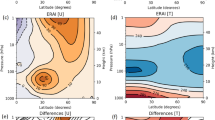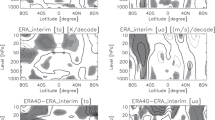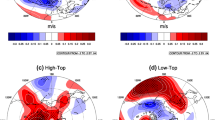Abstract
The European Consortium EC-EARTH climate model version 3.1 is used to assess the role of a well-resolved stratosphere on stratospheric teleconnections in the Northern Hemisphere winter. Two simulations of 100 years with constant radiative forcing, one with top at 0.01 hPa (L91, High-Top) and other with top at 5 hPa (L62, Low-Top) are compared. Results show how High-Top is able to generate a realistic Quasi-Biennial Oscillation in the tropical stratosphere, and to capture its teleconnection to the extratropics. On the other hand, EC-EARTH properly simulates the leading modes of variability (EOFs) of the polar stratosphere in both High-Top and Low-Top configurations, although the El Niño-related wave-like teleconnection dominates the signal of EOF3 (wavenumber 1 at 50 hPa) in High-Top, as in reanalysis, while the tropics-unrelated Pacific/North America pattern does it in Low-Top. At subseasonal time-scale, High-Top shows larger sudden stratospheric warming (SSW) occurrence in mid-winter, which is close to the documented in observational records, while SSW occurrence peaks by late-winter in Low-Top, despite both show a similar SSW decadal frequency (i.e. around 8 events per decade). Examination of the climatological eddy heat flux shows a misrepresentation of the seasonal cycle in Low-Top, with a peak in late-winter that explains the timing of SSW increase. This peak of the eddy heat flux can be traced to the wave injection over Central Siberia in the lower stratosphere, which appears to be dominated by small-scale waves (wavenumbers 3–4). It follows that simulating realistic eddy heat flux seasonality is fundamental to obtain a realistic SSW seasonal cycle.











Similar content being viewed by others
References
Ando Y et al (2018) Detection of a climatological short break in the polar night jet in early winter and its relation to cooling over Siberia. Atmos Chem Phys 18(17):12639–12661
Andrews DG, Holton JR, Leovy CB (1987) Middle atmosphere dynamics, vol 40. Academic Press, New York
Anstey JA, Shepherd TG (2014) High-latitude influence of the quasi-biennial oscillation. Q J R Meteorol Soc 140:1–21. https://doi.org/10.1002/qj.2132
Ayarzagüena B, Palmeiro FM, Barriopedro D, Calvo N, Langematz U, Shibata K (2019) On the representation of major stratospheric warmings in reanalyses. Atmos Chem Phys 19(14):9469–9484
Baldwin MP, Dunkerton TJ (1998) Biennial, quasi-biennial, and decadal oscillations of potential vorticity in the northern stratosphere. J Geophys Res 103:3919–3928
Baldwin MP, Dunkerton TJ (1999) Propagation of the Arctic Oscillation from the stratosphere to the troposphere. J Geophys Res Atmos 104:30937–30946. https://doi.org/10.1029/1999JD900445
Baldwin MP, O’Sullivan D (1995) Stratospheric effects of ENSO-related tropospheric circulation anomalies. J Clim 8:649–667
Baldwin MP, Dunkerton TJ (2001) Stratospheric harbingers of anomalous weather regimes. Science 294:581–584
Baldwin MP, Thompson DW (2009) A critical comparison of stratosphere–troposphere coupling indices. Q J R Meteorol Soc 135(644):1661–1672
Baldwin MP, Cheng X, Dunkerton TJ (1994) Observed correlations between winter-mean tropospheric and stratospheric circulation anomalies. Geophys Res Lett 21:1141–1144
Baldwin MP et al (2001) The quasi-biennial oscillation. Rev Geophys 39:179–229
Balsamo G, Viterbo P, Beljaars A, van den Hurk B, Hirschi M, Betts AK, Scipal K (2009) A revised hydrology for the ECMWF model: verification from field site to terrestrial water storage and impact in the integrated forecast system. J Hydrometeor 10:623–643
Barnston AG, Livezey RE (1987) Classification, seasonality and persistence of low-frequency atmospheric circulation patterns. Mon Weather Rev 115:1083–1126
Batté L, Doblas-Reyes FJ (2015) Accounting for model uncertainty in EC-Earth3: impact of SPPT on seasonal forecast quality. Clim Dyn 16:3532. https://doi.org/10.1007/s00382-015-2548-7
Bellprat O, Kotlarski S, Lüthi D, De Elía R, Frigon A, Laprise R, Schär C (2016) Objective calibration of regional climate models: application over Europe and North America. J Clim 29(2):819–838
Bladé I, Newman M, Alexander MA, Scott JD (2008) The late fall extratropical response to ENSO: sensitivity to coupling and convection in the tropical West Pacific. J Clim 21:6101–6118
Branstator G (2002) Circumglobal teleconnections, the jetstream waveguide, and the North Atlantic Oscillation. J Clim 15:1893–1910
Bueh C, Nakamura H (2007) Scandinavian pattern and its climatic impact. Q J R Meteorol Soc 133:2117–2131
Butchart N et al (2018) Overview of experiment design and comparison of models participating in phase 1 of the SPARC Quasi-Biennial Oscillation initiative (QBOi). Geosci Model Dev 11(3):1009–1032
Butler AH, Gerber EP (2018) Optimizing the definition of a sudden stratospheric warming. J Clim 31(6):2337–2344
Charlton AJ, Polvani LM (2007) A new look at stratospheric sudden warmings. Part I: climatology and modeling benchmarks. J Clim 20:449–469
Charlton-Perez AJ et al (2013) On the lack of stratospheric dynamical variability in low-top versions ofthe CMIP5models. J Geophys Res Atmos 118:2494–2505
Charney JG, Drazin PG (1961) Propagation of planetary- scale disturbances from the lower into the upper atmosphere. J Geophys Res 66:83–109. https://doi.org/10.1029/JZ066i001p00083
Christiansen B, Yang S, Madsen MS (2016) Do strong warm ENSO events control the phase of the stratospheric QBO? Geophys Res Lett 43(19):10–489
Cohen J, Jones J (2011) A new index for more accurate winter predictions. Geophys Res Lett 38:L21701. https://doi.org/10.1029/2011GL049626
Coy L, Eckermann S, Hoppel K (2009) Planetary wave breaking and tropospheric forcing as seen in the stratospheric sudden warming of 2006. J Atmos Sci 66(2):495–507
Davini P, von Hardenberg J, Corti S (2015a) Tropical origin for the impacts of the Atlantic multidecadal variability on the Euro-Atlantic climate. Environ Res Lett 10(9):094010
Davini P, von Hardenberg J, Filippi L, Provenzale A (2015b) Impact of Greenland orography on the Atlantic Meridional Overturning Circulation. Geophys Res Lett 42(3):871–879
Davini P et al (2017) Climate SPHINX: evaluating the impact of resolution and stochastic physics parameterisations in the EC-Earth global climate model. Geosci Model Dev 10(3):1383–1402
de la Cámara A, Albers JR, Birner T, García RR, Hitchcock P, Kinnison DE, Smith AK (2017) Sensitivity of sudden stratospheric warmings to previous stratospheric conditions. J Atmos Sci 74:2857–2877. https://doi.org/10.1175/JAS-D-17-0136.1
de la Cámara A, Birner T, Albers JR (2019) Are sudden stratospheric warmings preceded by anomalous tropospheric wave activity? J Clim. https://doi.org/10.1175/JCLI-D-19-0269.1
Dee D et al (2011) The ERA-Interim reanalysis: configuration and performance of the data assimilation system. Q J R Meteorol Soc 137:535–597
Deser C (2000) On the teleconnectivity of the ‘‘Arctic Oscillation’’. Geophys Res Lett 27:779–782
DeWeaver E, Nigam S (2002) Linearity in ENSO’s atmospheric response. J Clim 15:2446–2461
Díaz-Durán A, Serrano E, Ayarzagüena B, Abalos M, de la Cámara A (2017) Intra-seasonal variability of extreme boreal stratospheric polar vortex events and their precursors. Clim Dyn 49(9–10):3473–3491
Douville H (2009) Stratospheric polar vortex influence on Northern Hemisphere winter climate variability. Geophys Res Lett 36:L18703. https://doi.org/10.1029/2009GL039334
Dunn-Sigouin E, Shaw TA (2015) Comparing and contrasting extreme stratospheric events, including their coupling to the tropospheric circulation. J Geophys Res Atmos 120:1374–1390
Dunn-Sigouin E, Shaw TA (2018) Dynamics of extreme stratospheric negative heat flux events in an idealized model. J Atmos Sci 75:3521–3540
Ern M, Preusse P (2009) Quantification of the contribution of equatorial Kelvin waves to the QBO wind reversal in the stratosphere. Geophys Res Lett. https://doi.org/10.1029/2009GL040493
García-Serrano J, Haarsma RJ (2017) Non-annular, hemispheric signature of the winter North Atlantic Oscillation. Clim Dyn 48(11–12):3659–3670
García-Serrano J, Rodríguez-Fonseca B, Blade I, Zurita-Gotor P, de La Camara A (2011) Rotational atmospheric circulation during North Atlantic-European winter: the influence of ENSO. Clim Dyn 37:1727–1743. https://doi.org/10.1007/s00382-010-0968-y
García-Serrano J, Cassou C, Douville H, Giannini A, Doblas-Reyes FJ (2017) Revisiting the ENSO teleconnection to the tropical North Atlantic. J Clim 30(17):6945–6957
Garfinkel CI, Hartmann DL, Sassi F (2010) Tropospheric precursors of anomalous Northern Hemisphere stratospheric polar vortices. J Clim 23(12):3282–3299
Gerber EP et al (2010) Stratosphere-troposphere coupling and annular mode variability in chemistry-climate models. J Geophys Res 115:D00M06. https://doi.org/10.1029/2009jd013770
Gerber EP, Butler A, Calvo N, Charlton-Perez AJ, Giorgetta M, Manzini E, Perlwitz J (2012) Assessing and understanding the impact of stratospheric dynamics and variability on the earth system. Bull Am Meteorol Soc 93:845–859. https://doi.org/10.1175/BAMS-D-11-00145.1
Hardiman SC, Butchart N, Hinton TJ, Osprey SM, Gray LJ (2012) The effect of a well-resolved stratosphere on surface climate: differences between CMIP5 simulations with high and low top versions of the Met Office Climate Model. J Clim 25(20):7083–7099
Hazeleger W et al (2010) EC-Earth: a seamless earth-system prediction approach in action. Bull Am Meteorol Soc 91:1357–1363. https://doi.org/10.1175/2010BAMS2877.1
Hazeleger W et al (2012) EC-Earth V2.2: description and validation of a new seamless earth system prediction model. Clim Dyn 39:2611–2629
Hitchcock P, Simpson IR (2014) The downward influence of stratospheric sudden warmings. J Atmos Sci 71:3856–3876. https://doi.org/10.1175/JAS-D-14-0012.1
Holton JR, Tan HC (1980) The influence of the equatorial quasi-bien- nial oscillation on the global circulation at 50 mb. J Atmos Sci 37:2200–2208
Hsu H-H, Wallace JM (1985) Vertical structure of wintertime teleconnection patterns. J Atmos Sci 42:1693–1710
Hu Y, Tung KK (2003) Possible ozone-induced long-term changes in planetary wave activity in late winter. J Clim 16(18):3027–3038
Kidston J, Scaife AA, Hardiman SC, Mitchell DM, Butchart N, Baldwin MP, Gray LJ (2015) Stratospheric influence on tropospheric jet streams, storm tracks and surface weather. Nat Geosci 8:433–440
Kim J, Son SW, Gerber EP, Park HS (2017) Defining sudden stratospheric warming in climate models: accounting for biases in model climatologies. J Clim 30(14):5529–5546
Koenigk T, Brodeau L (2017) Arctic climate and its interaction with lower latitudes under different levels of anthropogenic warming in a global coupled climate model. Clim Dyn 49(1–2):471–492
Kolstad EW, Charlton-Perez AJ (2011) Observed and simulated precursors of stratospheric polar vortex anomalies in the Northern Hemisphere. Clim Dyn 37(7–8):1443–1456
Limpasuvan V, Thompson DW, Hartmann DL (2004) The life cycle of the Northern Hemisphere sudden stratospheric warmings. J Clim 17(13):2584–2596
Linkin ME, Nigam S (2008) The North Pacific Oscillation–west Pacific teleconnection pattern: mature-phase structure and winter impacts. J Clim 21(9):1979–1997
Lott F et al (2014) Kelvin and Rossby-gravity wave packets in the lower stratosphere of some high-top CMIP5 models. J Geophys Res Atmos 119(5):2156–2173
Madec G (2008) NEMO ocean engine technical report 27. Note du Pole de modélisation, Institut Pierre‐Simon Laplace (IPSL)
Manzini E et al (2014) Northern winter climate change: assessment of uncertainty in CMIP5 projections related to stratosphere-troposphere coupling. J Geophys Res Atmos 119(13):7979–7998
Mezzina B, Garcia-Serrano J, Bladé I, Kucharski F (2020a) Dynamics of the ENSO teleconnection and NAO variability in the North Atlantic-European late winter. J Clim 33(3):907–923
Mezzina B, Garcia-Serrano J, Bladé I, Palmeiro FM, Ardilouze C, Batté L, Benassi M, Gualdi S (2020b) Multi-model assessment of the late-winter ENSO teleconnection in the Euro-Atlantic sector. Clim Dyn (submitted)
Newman PA, Nash ER (2000) Quantifying the wave driving of the stratosphere. J Geophys Res Atmos 105(D10):12485–12497
Nigam S (2003) Teleconnections. Encyclopedia of atmospheric sciences. Academic Press, London, pp 2243–2269
Nigam S, Baxter S (2015) Teleconnections. Encyclopedia of atmospheric sciences, 2nd edn G North Ed. Elsevier Science, pp 90–109. https://doi.org/10.1016/b978-0-12-382225-3.00400-x
Nishii K, Nakamura H, Miyasaka T (2009) Modulations in the planetary wave field induced by upward propagating Rossby wave packets prior to stratospheric sudden warming events: a case- study. Q J R Meteor Soc 135:39–52. https://doi.org/10.1002/qj.359
O’Sullivan D, Young R (1992) Modeling the quasi-biennial oscillation’s effect of the winter stratospheric circulation. J Atmos Sci 49:2437–2448
O’Sullivan D, Dunkerton TJ (1995) Generation of inertia–gravity waves in a simulated life cycle of baroclinic instability. J Atmos Sci 52:3695–3716
Orr A, Bechtold P, Scinocca J, Ern M, Janiskova M (2010) Improved middle atmosphere climate and forecasts in the ECMWF model through a non-orographic gravity wave drag parameterization. J Clim 23:5905–5926
Palmeiro FM, Barriopedro D, García-Herrera R, Calvo N (2015) Comparing sudden stratospheric warming definitions in reanalysis data*. J Clim 28(17):6823–6840. https://doi.org/10.1175/JCLI-D-15-0004.1
Perlwitz J, Graf HF (1995) The statistical connection between tropospheric and stratospheric circulation of the Northern Hemisphere in winter. J Clim 8:2281–2295
Perlwitz J, Graf HF (2001) Troposphere-stratosphere dynamic coupling under strong and weak polar vortex conditions. Geophys Res Lett 28(2):271–274
Perlwitz J, Graf HF, Voss R (2000) The leading variability mode of the coupled troposphere-stratosphere winter circulation in different climate regimes. J Geophys Res Atmos 105(D5):6915–6926
Polvani LM, Waugh DW (2004) Upward wave activity flux as a precursor to extreme stratospheric events and subsequent anomalous surface weather regimes. J Clim 17:3548–3554
Rayner NA et al (2003) Global analyses of sea surface temperature, sea ice, and night marine air temperature since the late nineteenth century. J Geophys Res 108:4407. https://doi.org/10.1029/2002JD002670
Robertson AW, Ghil M (1999) Large-scale weather regimes and local climate over the western United States. J Clim 12(6):1796–1813
Roff G, Thompson DWJ, Hendon H (2011) Does increasingmodel stratospheric resolution improve extended-range forecast skill? Geophys Res Lett 38:L05809. https://doi.org/10.1029/2010GL046515
Scaife AA, Butchart N, Warner CD, Stainforth D, Norton W, Austin J (2000) Realistic quasi-biennial oscillations in a simulation of the global climate. Geophys Res Lett 27:3481–3484
Scaife AA, Knight JR, Vallis GK, Folland CK (2005) A stratospheric influence on the winter NAO and North Atlantic surface climate. Geophys Res Lett 32:L18715. https://doi.org/10.1029/2005GL023226
Scinocca JF (2003) An accurate spectral nonorographic gravity wave drag parameterization for general circulation models. J Atmos Sci 60(4):667–682
Shaw TA, Perlwitz J (2013) The life cycle of Northern Hemisphere downward wave coupling between the stratosphere and troposphere. J Clim 26:1745–1763
Shaw TA, Perlwitz J, Weiner O (2014) Troposphere–stratosphere coupling: links to North Atlantic weather and climate, including their representation in CMIP5 models. J Geophys Res Atmos 119:5864–5880. https://doi.org/10.1002/2013JD021191
Smoliak BV, Wallace JM (2015) On the leading patterns of Northern Hemisphere sea level pressure variability. J Atmos Sci 72(9):3469–3486
Stockdale T, Kim YH, Anstey JA, Palmeiro FM, Butchart N, Scaife AA, Andrews M, Bushell AC, Dobrynin M, García-Serrano J, Hamilton K, Kawatani Y, Lott F, McLandress C, Naoe H, Osprey S, Pohlmann H, Scinocca J, Watanabe S, Yoshida K, Yukimoto S (2020) Prediction of the quasi-biennial oscillation with a multi-model ensemble of QBO-resolving models. Q J R Meteorol Soc (submitted)
Strauss DM, Shukla J (2000) Distinguishing between the SST-forced and internal variability in mid latitudes: analysis of observations and GCM simulations. Q J R Meteorol Soc 126:2323–2350
Strauss DM, Shukla J (2002) Does ENSO force the PNA? J Clim 15:2340–2358
Takahashi M (1996) Simulation of the stratospheric quasi-biennial oscillation using a general circulation model. Geophys Res Lett 23:661–664
Thompson DWJ, Wallace JM (1998) The Arctic Oscillation signature in the wintertime geopotential height and temperature fields. Geophys Res Lett 25:1297–1300
Thompson DWJ, Wallace JM (2000) Annular modes in the extratropical circulation. Part I: month-to-month variability. J Clim 13:1000–1016
Thompson DWJ, Lee S, Baldwin MP (2003) Atmospheric processes governing the Northern Hemisphere Annular mode/North Atlantic Oscillation. In: Hurrell JW, Kushnir Y, Ottersen G, Visbeck M (eds) The North Atlantic Oscillation: climate significance and environmental impact. Geophysical Monographic Series, vol 134, pp 81–112
Tripathi OP, Baldwin M, Charlton-Perez AJ, Charron M, Eckermann SD, Gerber E, Harrison RG, Jackson DR, Kim B-M, Kuroda Y, Lang A, Mahmood S, Mizuta R, Roff G, Sigmond M, Son SW (2015a) The predictability of the extratropical stratosphere on monthly time-scales and its impact on the skill of tropospheric forecasts. Q J R Meteorol Soc 141:987–1003. https://doi.org/10.1002/qj.2432
Tripathi OP, Charlton-Perez A, Sigmond M, Vitart F (2015b) Enhanced long-range forecast skill in boreal winter following stratospheric strong vortex conditions. Environ Res Lett 10:104007. https://doi.org/10.1088/1748-9326/10/10/104007
Valcke S (2013) The OASIS3 coupler: a European climate modelling community software. Geosci Model Dev 6:373–388
Vallis GK, Gerber EP (2008) Local and hemispheric dynamics of the North Atlantic Oscillation, annular patterns and the zonal index. Dyn Atmos Ocean 44:184–212
Vancoppenolle M, Bouillon S, Fichefet T, Goosse H, Lecomte O, Morales Maqueda MA., Madec G (2012) The Louvain-la-Neuve sea ice model. Notes du pole de modélisation, Institut Pierre-Simon Laplace (IPSL), Paris, France, 31
von Storch H, Zwiers FW (2001) Statistical analysis in climate research. Cambridge University Press, Cambridge
Walker GT, Bliss YEW (1932) World weather V. Men R Meteorol Soc 4:53–84
Wallace JM, Gutzler DS (1981) Teleconnections in the geopotential height field during the Northern Hemisphere winter. Mon Weather Rev 109:784–812
Wettstein JJ, Wallace JM (2010) Observed patterns of month-to-month storm-track variability and their relationship to the background flow. J Atmos Sci 67(5):1420–1437
Zhang JK, Tian WS, Chipperfield MP, Xie F, Huang JL (2016) Persistent shift of the Arctic polar vortex towards the Eurasian continent in recent decades. Nat Clim Change 6:1094–1099. https://doi.org/10.1038/NCLIMATE3136
Acknowledgements
This work has been supported by the Spanish DANAE project (CGL2015-68342-R) and received funding from the EU H2020-funded PRIMAVERA project (GA 641727). FMP was partially supported by the EU-ERA4CS MEDSCOPE (GA 689029) and the Spanish GRAVITOCAST (ERC2018-092835) projects. JG-S was partially supported by the ‘Ramón y Cajal’ programme (RYC-2016-21181). Red Española de Supercomputación is acknowledged for awarding computing resources (RES projects AECT-2017-3-0015 and AECT-2018-2-0023). Technical support at BSC (Computational Earth Sciences group) is sincerely acknowledged. The authors are grateful to the anonymous reviewers for their comments, which helped to improve the scope of the manuscript.
Author information
Authors and Affiliations
Corresponding author
Additional information
Publisher's Note
Springer Nature remains neutral with regard to jurisdictional claims in published maps and institutional affiliations.
Appendix
Appendix
Vertical cross-section of monthly zonal-mean zonal wind at the equator (Ueq) in the (top) High-Top and (bottom) Low-Top simulations. Shading is every 2 ms−1, orange for westerlies and purple for easterlies. Black contour stands for the zero-wind line, and the horizontal dashed line indicates the 50 hPa level used to define the QBO phases
As Fig. 2, but for ERA-Interim over 1979–2012
As Fig. 10, but for ERA-Interim over 1979–2012
Rights and permissions
About this article
Cite this article
Palmeiro, F.M., García-Serrano, J., Bellprat, O. et al. Boreal winter stratospheric variability in EC-EARTH: High-Top versus Low-Top. Clim Dyn 54, 3135–3150 (2020). https://doi.org/10.1007/s00382-020-05162-0
Received:
Accepted:
Published:
Issue Date:
DOI: https://doi.org/10.1007/s00382-020-05162-0








